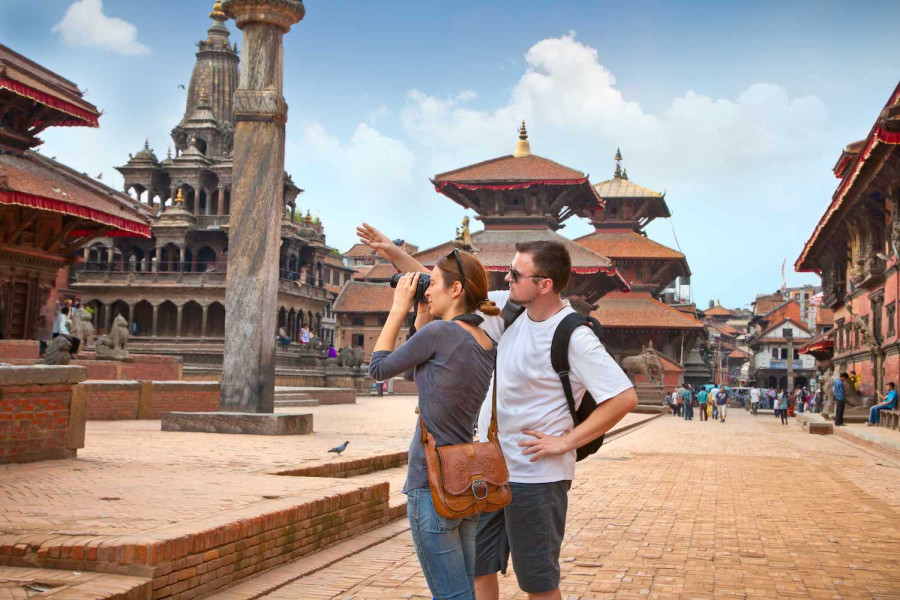Money
Nepal’s tourism paid for 1.19 million jobs in 2023
Planned expansion at Kathmandu airport may hit sector, as could the lack of leadership in the tourism board.
Sangam Prasain
Nepal’s tourism sector generated Rs327.9 billion ($2.5 billion) in revenue and supported 1.19 million jobs directly and indirectly last year, according to the recently released annual World Travel and Tourism Council research report. The report forecasts that Nepal will generate 1.22 million jobs in 2024.
The jobs generated by the tourism sector is 15.2 percent of the total.
The London-based organisation said travel and tourism’s total contribution to the country’s gross domestic product (GDP) stood at 6.6 percent to Rs358.9 billion or $2.7 billion last year, down from 6.7 percent in 2019 before the start of the Covid pandemic.
All values are in constant 2023 prices and exchange rates.
This primarily reflects the economic activity generated by sectors such as hotels, travel agencies, airlines and other passenger transport services, excluding commuter services. It also includes, for example, the activities of the restaurant and leisure industries directly supported by tourists.
The annual report said domestic visitors are the biggest spenders who spent Rs210.8 billion last year and are expected to fork out Rs226.8 billion this year. This translates to 71.5 percent of the total spending in the tourism sector.
Nepalis started touring their own country in significant numbers after the 2015 earthquake, according to hoteliers.
Apart from traditional leisure destinations like Pokhara and Chitwan, the famous Annapurna Base Camp trail, Mardi and Manaslu treks were the big draw for domestic adventurers. But the Covid pandemic had put a damper on tourism.
“Domestic tourism has now fully recovered,” said Mani Raj Lamichhane, director at the Research, Planning and Monitoring Department of Nepal Tourism Board (NTB).
“There is no actual data on domestic movement but based on the occupancies reported by hotels in key tourism hubs like Pokhara and Chitwan, the domestic tourist growth has been phenomenal,” said Lamichhane.
“Due to bad roads, domestic tourist movement in Lumbini, however, has dropped significantly, even though Pokhara has not been much affected.”
Domestic airlines are reporting robust passenger traffic in destinations like Pokhara, Bhairahawa and Bharatpur due to the ongoing road expansion projects.
“We are operating 40 flights [landing and takeoff] from the Pokhara International Airport, with the number of flights doubling in the past six months,” said Dipendra Karna, communication manager at Buddha Air, Nepal’s largest domestic carrier.
Buddha operates 34 flights on the Pokhara-Kathmandu-Pokhara route and connects Nepalgunj, Bhairahawa and Bharatpur with Pokhara.
On April 14, Buddha Air recorded the highest-ever single-day passenger traffic, flying 3,000 passengers in and out of Pokhara.
Karna said passengers in key tourist destinations are mostly Nepalis followed by Indians.
“We are 95 percent occupied in Pokhara,” said Karna.
Besides, the number of sightseers travelling from Beni to Jomsom by motorcycle has also risen sharply after the construction of the Beni-Jomsom road.
According to the report, international visitors spent an estimated Rs83.9 billion or $633.7 million last year. This spending is projected to grow to Rs102.6 billion in 2024.
Of the total expenditure, 83.4 percent was spent on leisure and the remaining on business.
The country welcomed more than a million tourists between January and December last year, following China’s border reopening and record arrivals from India.
According to the Nepal Tourism Board, the country's tourism promotional body, the arrival numbers crossed the million mark for the first time in four years.
The government, through the budget, has announced to draw 1.6 million foreign visitors this year.
According to industry insiders, the government’s target is attainable, but there are a few challenges this year.
From November 8, Kathmandu’s Tribhuvan International Airport will be closed daily for 10 hours, from 10 pm to 8 am for five months until March 31, for the expansion of the taxiways.
September-November is Nepal’s peak tourist season.
“The construction in the peak season will reduce flight frequency and as a result, airfare may rise,” said Lamichhane.
Subash Jha, spokesperson at Kathmandu’s Tribhuvan International Airport, said that at least 12 flights may be affected. “As there are no parking slots during daytime, rescheduling will be difficult. We, however, have requested airline companies to use Nepal’s two new international airports in Pokhara and Bhairahawa. We are ready to facilitate them.”
Jha said a round of discussion with a few foreign airlines has been completed to ensure the flights do not suffer. “It will depend on airlines whether they are willing to operate from the new airports. We, however, cannot force them.”
Besides, industry insiders say the Nepal Tourism Board has been headless for the past four months, affecting all international promotional and marketing events.
Foreign arrivals had crossed the one million mark for the first time in 2018 when the country hosted 1.17 million visitors from abroad.
The number reached 1.19 million in 2019. Then the Covid pandemic started in early 2020, bringing arrivals to a standstill. Travel restrictions and an economic slowdown triggered by the pandemic delivered a massive blow to Nepal's burgeoning tourism industry, decimating revenues and profits after 2020.
Nepal received 230,085 and 150,962 tourists in 2020 and 2021, respectively. In 2022, the foreign tourist numbers shot up to 614,869.




 9.12°C Kathmandu
9.12°C Kathmandu













%20(1).jpg&w=300&height=200)
